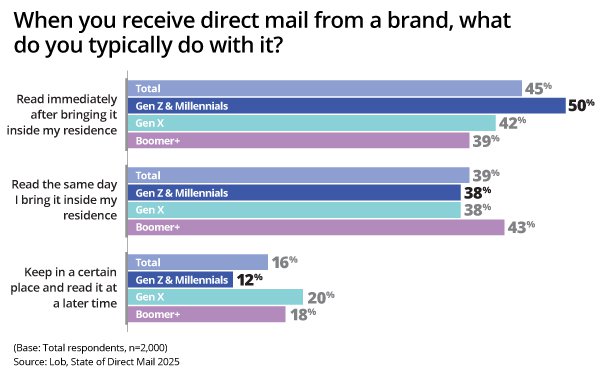
It’s time to look at the
precursor to email and just about every digital channel — good, old-fashioned direct mail.
Younger consumers in particular prefer the channel, according
to State of Direct Mail 2025: Consumer Insights Edition, a study from Lob.
Of those surveyed, 85% of Gen Z and Millennials engage with direct mail. And overall, 84% of consumers read it
the same day they receive it, up from 70% in 2024.
Among Gen Z and millennials, 29% have purchased in response to direct mail, versus a general average of 23%. And 19% have done so at
least once, in line with the average. But 41% of boomers have ordered at least once.
What can consumers possibly like about the medium once called junk mail? They
say:
- It often includes helpful info (e.g., discounts, offers, important financial or healthcare details) — 42%
- I’m more
likely to notice and remember it — 35%
- It’s a physical reminder I can keep or act on later — 34%
- It shows the brand made an effort
— 31%
- I like getting something from the mailbox — 25%
- It stands out from the clutter of digital ads and emails — 23%
- It makes the brands feel more trustworthy and credible — 23%
- I enjoy having something tangible to hold — 20%
- I
like seeing brand design and packaging in print — 20%
- I don’t like anything about receiving direct mail — 14%
advertisement
advertisement
All that said, email is
the channel most tightly integrated with direct mail.
Of the consumers surveyed, 41% are more likely to engage with an email or text after receiving a piece of postal mail. The downside
is that only 18% have signed up for an email list as a result.
And, some aspects of direct mail turn people off.
For one, many find it impersonal. Indeed, 52%
say it sometimes looks like a scam or mass-produced material. And many are turned off by bad personalization.
Case in point: 33% are offended when a direct mailer tries too
hard to be personal, but feels fake. And an equal percentage dislike it when the piece “mentions info I didn’t knowingly share.”
In addition, 27% dislike it when a direct
mailing tries to be personalized, but gets basic information wrong.
That’s one advantage of email: it can personalize dynamically.
In partnership with
Kelsey White and PureSpectrum, Lob surveyed 2,000 consumers between April and May 2025.